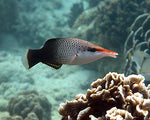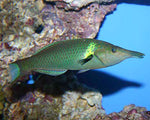The most unique aspect about the Bird Wrasse is its elongated beak which is used to catch long, skinny prey and hold it captive while breaking it up into bite-size pieces. The female is brownish black, and the male is variations of green. For this reason the male is often called the Green Bird Wrasse, and the female, the Black or Brown Bird Wrasse.
West-Indo Pacific Region:: Gomphosus varius. Indian Ocean-Red Sea Region:: Gomphosus caeruleus. Other Common Names:: Bird Fish, Birdfish, Blue Bird Wrasse, Blue-Green Bird Wrasse, Black Bird Wrasse, Brown Bird Wrasse, Green Bird Wrasse, Indian Ocean Bird Wrasse, Red Sea Bird Wrasse.
Named for their distinctive bird-like beaked snouts, and sexed by colors, Bird Wrasses are easy to identify. As juveniles, each species has their own unique transitional juvenile to adult colors and markings.
G. varius males are typically medium to dark green or greenish-blue in color. Females are creamy white colored in front and dark brown to nearly black in back. G. caeruleus males are much bluer in color. Females from front to back are white to yellow on the bottom and greenish-blue on top. Both female species have bottom half white and top half peachy colored snouts.
In the wild a single male congregates with a large harem of females. Nature's way of propagating the species is that a single female will change into a male, separate from the group, and once fully transformed starts a harem of its own. For a period of time during this female to male transformation the fish possesses colors of both sexes, but eventually turns into an all green adult male.








